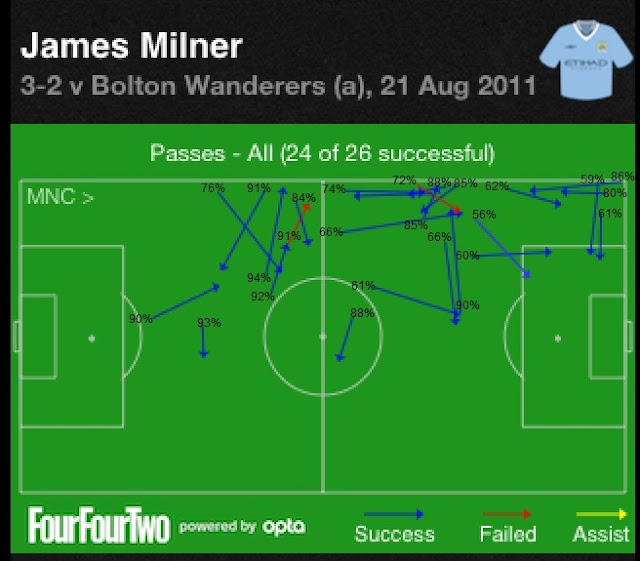I've recorded most of James Milner's passing attempts from a screen grab of the FourFourTwo Opta powered app from Manchester City's trip to Bolton in August 2011. A game which is fast becoming the most analysed match of all time. Each pass has been assigned a likelihood of completion based around the success rates of the 1,000 or so passes made by the other 26 participating players from the fixture. The origin of each pass and the position of the intended target is the primary driving force for the calculations.
Milner's attempts have been split into three roughly 30 minute periods for no other reason than to make the plots more easily viewed. It may be that the splits show an ebb or flow of attacking or defensive intent or an increase in adventure followed by a more cautious final third. But it's easy to be wise in hindsight or see patterns that have only descriptive validity. Therefore I am merely presented the passing charts to give a feel for the estimated difficulty of a wide range of passes.
The midfielder was heavily involved in most areas of the pitch and is an excellent choice to display a varied passing repertoire. He completed an above average number of his pass attempts (53 against a predicted 47) but he was also adventurous enough to misplace 10 passes and create two goals.
Difficulty Of Milner's Passes At Bolton, KickOff Until 30th Minute. 2011/12.
Milner's attempts have been split into three roughly 30 minute periods for no other reason than to make the plots more easily viewed. It may be that the splits show an ebb or flow of attacking or defensive intent or an increase in adventure followed by a more cautious final third. But it's easy to be wise in hindsight or see patterns that have only descriptive validity. Therefore I am merely presented the passing charts to give a feel for the estimated difficulty of a wide range of passes.
The midfielder was heavily involved in most areas of the pitch and is an excellent choice to display a varied passing repertoire. He completed an above average number of his pass attempts (53 against a predicted 47) but he was also adventurous enough to misplace 10 passes and create two goals.
Difficulty Of Milner's Passes At Bolton, KickOff Until 30th Minute. 2011/12.

Difficulty Of Milner's Passes At Bolton, 31st Minute Until 60th Minute. 2011/12.
The main purpose of the three graphics is to give the opportunity to eyeball a large variety of different passes and to see if their associated completion expectations appear reasonably sensible, but on a narrower scale they also highlight Milner's contribution to City's 3-2 victory at The Reebok.
The expected increase in difficulty of completions as players move from their own goal towards their opponents is well demonstrated by the figures. Obviously the physical act of passing a ball five yards is the same wherever it is undertaken on the pitch, but the level of difficulty changes because of the environment.
Tactically few teams press high up the pitch and if they do the pressers are always outnumbered by the passers. Also, once we also acknowledge the ability of the passer to chose his pass, it's unsurprising to see most passes made entirely within a player's own half have expected success rates of mid to high 80's and above.
Based on this limited dataset passes made from the flanks towards the centre circle appear as the most risky passes made from wholly within a player's own half (although a completion is still as likely as Chelsea beating Stoke at The Bridge). These type of attempts, if intercepted presumably offer excellent counter attacking possibilities, so opponents may be prepared to gamble on an interception knowing that the risk is far outweighed by the potential reward.
The balance between passer and would be interceptor or tackler begins to become more even as the advancing player puts the centre circle behind him and length of pass and direction begins to have an impact on completion rates. Players appear to be able to comfortably circulate the ball in areas between the two arcs, but increased pass length quickly drops expectations to below coin toss levels, as does any attempt to deeply penetrate the penalty box. The best passers of the ball will be operating in these more advanced areas, but they will be faced with more numerous and more skilled tacklers and defenders. So the skill levels of the contestants both begin to rise compared to less advanced passing zones.
As noted in previous posts, passes to the flanks aren't defended as vigourously and backward passes, even from very advanced areas usually have a high incidence of success.
Data from a single game is sufficient to lay down a framework with which to begin to analyse passing outcomes. With a greatly extended database, it should be possible to begin to discern team tendencies as well as the strengths and weakness of individual players and the part they play in a team's wider passing agenda. If we can further develop the models to include the presence of defending players it may also be possible to determine if players are passing poorly because they are simply poor passers or because they are good passers who are making flawed decisions around their choice of pass.


I'm curious what kind of math you used to get the expected pass completion rates. Please explain that aspect a bit more.
ReplyDeleteReally like your analysis though :)
Hi Pierre, I'm using a logistic regression where the output is categorical, either a success or a failure and the inputs are the field co ordinates for the start and end of the intended pass.
ReplyDeleteThanks for the comments :-).
Mark